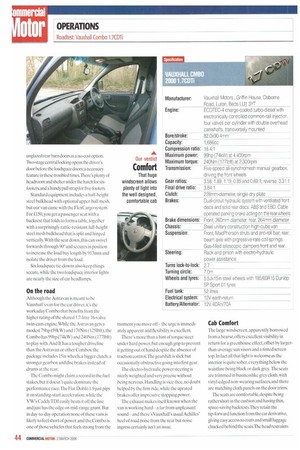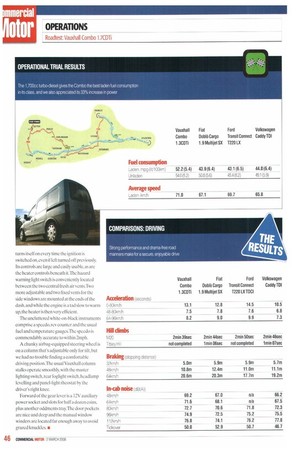ARR VAL 0
Page 42

Page 44

Page 45

Page 46

If you've noticed an error in this article please click here to report it so we can fix it.
The new hatchback aside, it may not look
much different. But Vauxhall's Combo has been steadily evolving, especially under the bonnet.
How time flies. It's nearly three years since we last drove aVauxhall Combo with a 1.7-litre engine:since then it's gained common-rail injection together with 33% more power and 45% more torque. In those days it was also Britain's best-selling light van, hut that was before Ford's Transi t Connect came along to queer its pitch.Vauxhall's share was hit significantly by the newcomer, but Luton is now fighting back and rapidly closing the gap on the Essex boys. Last year Ford's lead shrank from 6,599 to just 2210.
The Combo line-up has been expanded to include a hatchback,which not only extends its operational appeal to another market niche: it also does a good job of freshening the van's appearance.The current Combo is the first of its line to have integrated styling rather than a box on the back of a hatchback and the hatch makes the rear end smoother and less cluttered. That, along with our test van's tasteful blue-grey metallic paint and smart plastic wheel trims. makes the Combo remarkably pleasing on the eye. But let's not get carried away it's just a van, after all. How it earns its keep is more important than how it looks.
Productivity
Three Euro-4 power units are now available for the Combo, including the 1.4i 16v petrol engine and two very different turbo-diesels: the 1.3CDTiand the 1.7CDTi.The theory behind having a small, relatively stressed engine and a larger, lazy one in the same range is that the first is efficient under easy going and the second is at its best when things gets tougher.
Comparing the 1.7CDTi tested here with the 1.3CDTi tested last autumn (CM 15 September 2005 ) puts that theory to the test. The 1.7's laden figure of 52.2mpg is 2.0mpg better than the 1.3,but its unladen figure of 55.8mpg is 0.9mpg worse than the 1.3.Theory confirmed: the more power you have, the smaller the penalty you pay for running laden.
The Combo's 52.2mpg also happens to be the best figure yet recorded for a fully laden high-cube van; it's knocking on the door of the hatehvan sector at three-quarters of the GVW.
The Combo range nominally comes in two versions,1700 and 2000, which refer to the gross weight. In practice, and according to engine spec, the 1700 has GVWs ranging from 1,710 to 1,870kg, while the 2000 comes at 1,925kg (petrol) or 1,995kg (diesel).The 2000 1.4i offers the best net payload in the range at 725kg with a full tank and 75kg driver, while our test van comes in at 664kg. Vans like the Caddy and Transit Connect offer true 8(X)kgplus payloads, but only by exceeding the 2,000kg cut-off point for higher speed limits.
Access to the loadspace is flexible according to your needs.You can specify side loading doors on the nearside, as we had,or on both sides,fori235 or £400 respectively.The top-hinged hatch that defines this van is a fl 00 option,including window heating and wash/wipe,or have
unglazed rear barn doors as a no-cost option. Two-stage central locking opens the driver's door before the loadspace doors;a necessary feature in these troubled times.There's plenty of headroom and shelter under the hatch for sixfooters,and a handy pull strap for five-footers.
Standard equipment includes a half-height steel bulkhead with optional upper-half mesh, but our van came with the FlexCargo system. For £150, you get a passenger seat with a backrest that folds to form a table, together with a surprisingly rattle-resistant full-height steel mesh bulkhead that is split and hinged vertically. With the seat down, this can swivel forwards through 90" and secures in position to increase the load bay length by 913mm and isolate the driver from the load.
Six loadspace tie-downs also keep things secure, while the two loadspace interior lights are nearly the size of car headlamps.
On the road
Although the Astravan is meant Lobe Vauxhall's van for the car driver, it's the workaday Combo that benefits from the higher rating of the shared 1.7-litre 16-valve twin-cam engine. While the Astravan gets a modest 79hp (59kW) and 1701\1m (1251bft), the Combo has 99hp (74kW) and 240Nm (1771bft) to play with.And It has a tougher driveline than the A stravan or other Combos: the package includes 15in wheels, a bigger clutch, a stronger gearbox and disc brakes instead of drums at the rear.
The Combo might claim a record in the fuel stakes, but it doesn't quite dominate the performance race.The Fiat DoblO 1.9 just pips it on standing-start acceleration, while the VW's CaddyTDI easily beats it off the line and just has the edge on mid-range grunt. But in day-to-day operation none of these vans is likely to feel short of power, and the Combo is one of those vehicles that feels strong from the moment you move off— the urge is immediately apparent and flexibility is excellent.
There's more than a hint of torque steer under hard power, but enough grip to prevent it getting out of hand despite the absence of traction control.The gearshift is slick but occasionally obstructive going into first gear.
The electro-hydraulic power steering is nicely weighted and very precise without being nervous. Handling is vice-free, no doubt helped by the firm ride, while the uprated brakes offer impressive stopping power.
The exhaust makes itself known when the van is working hard— a far from unpleasant sound —and there's Vauxhall's usual Achilles' heel of road noise from the rear but noise ingress certainly isn't an issue.
Cab Comfort
The large windscreen, apparently borrowed from a hearse, offers excellent visibility in return for a greenhouse effect, offset by largerthan-average sun visors and a tinted screen top. In fact all that light is welcome as the interior is quite sober, everything below the waistline being black or dark grey. The seats are trimmed in businesslike grey cloth. with vinyl-edged non-wearing surfaces, and there are matching cloth panels on the door trims.
The seats are comfortable, despite being rather short in the cushion and having thin, space-saving baekrests.They retain the tip-forward function from the car derivative, giving easy access to coats and small luggage chucked behind the seats.The head restraints
feel solid, the seat-belts are height adjustable, and coat hooks are mounted on both A-pillars There are also handy lidded storage boxes under the forward load floor.one of which is marked First Aid. A generously sized glovebox can't be locked, but does come with spaces for fuel cards, a pen and a cup.There are numerous other storage areas around the cab,with a large flock-lined, rattle-free shelf above the screen.
Our test van was short of expensive interior options, but it certainly wasn't Spartan. Although the windows are manually wound, the large, square convex mirrors, which provide an excellent view and have a wideangle zone on the driver's side, are remotely adjustable as standard. Standard audio fit is the CD30 radio/single CD player. with its thief-confounding remote display.As well as radio information, the secondary display also shows the time, date and outside temperature. The clock is selfcorrecting via the RDS signal,so there's no excuse for a late delivery One annoying feature of the radio is that it turns itself on every time the ignition is switched on,even if left turned off previously. Its controls are large and easily usable, as arc the heater controls beneath it.The hazard warning light switch is conveniently located between the two central fresh air vents.Two more adjustable and two fixed vents for the side windows are mounted at the ends of the dash, and while the engine is a tad slow to warm up, the heater is then very efficient.
The uncluttered white-on-black instruments comprise a speedo, rev counter and the usual fuel and temperature gauges.The speedo is commendably accurate to within 2mph.
A chunky airbag-equipped steering wheel is on a column that's adjustable only for tilt, but we had no trouble finding a comfortable driving position.The usual Vauxhall column stalks operate smoothly, with the master lighting switch, rear foglight switch, headlamp levelling and panel-light rheostat by the driver's right knee.
Forward of the gear lever is a 12V auxiliary power socket and slots for half a dozen coins, plus another oddments tray.The door pockets are nice and deep and the manual window winders are located far enough away to avoid grazed knuckles. •
















































































































































































































